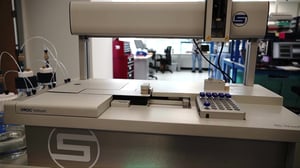
Extensional Viscosity with m-VROC II Viscometer
How do I Accurately Measure Extensional Viscosity?
Extensional viscosity is a critical parameter for characterizing fluids, such as paints, coatings, and inks, that experience extensional deformation during manufacturing, processing, or application. Extensional rheological measurements were once obtained with the beloved Caber extensional viscometer which has been discontinued.
Now, m-VROC II can be your viscometer that guides you simply to precise data to support formulation, quality control, and process optimization in these and other applications.
The m-VROC II measures extensional viscosity using a small sample volume (<1.5 mL) and offers a wide dynamic range under precise temperature control.
We tested an off-the-shelf paint across a wide range of extensional rates at a controlled temperature of 25 °C. The test was conducted as follows:
- Two chips were used for testing: EB20 and EE20 extensional chips.
- For the EB20, ~100 μL of sample was loaded into the syringe. For the EE20 chip ~1.5 mL of sample was front- loaded into a 2.5 mL syringe.
- Extensional viscosity data was gathered across a broad range of extensional rates using the software’s automatic measurement features. The software will know what rates for you to pick so in the case you are not sure, you can still run like an expert.
- The cleaning solvent order on CCS includes 2.5 % Aquet, DI water, and Acetone.
The paint exhibits non-Newtonian extensional thinning behavior, with viscosity decreasing from ~270 Pa-s to 4 Pa-s as the extensional rate increases from 0.9 s⁻¹ to 14,000 s⁻¹. The data demonstrates high measurement repeatability showcasing the capability of obtaining accurate and precise data without expertise using VROC technology. Paint, coatings, and thick samples can be challenging to work with in general but can be ran seamlessly through m-VROC II.




-1.png?width=302&height=302&name=Brochure%20m-VROC%20II%20App%20Note%20Tile%20(small)-1.png)

.jpeg?width=300&name=Woman%20scientist%2c%20documents%20and%20hands%20writing%20_575258496-min(1).jpeg)
